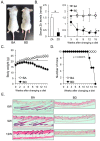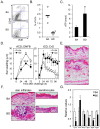Biotin Is Required for the Zinc Homeostasis in the Skin
- PMID: 31022908
- PMCID: PMC6520690
- DOI: 10.3390/nu11040919
Biotin Is Required for the Zinc Homeostasis in the Skin
Abstract
Patients with biotin deficiency present symptoms that are similar to those in patients with acrodermatitis enteropathica (inherent zinc deficiency). However, the association between biotin and zinc deficiency remains unknown. We have previously shown that epidermal keratinocytes of mice fed zinc-deficient (ZD) diets secreted more adenosine triphosphate (ATP) than those of mice fed zinc-adequate (ZA) diets and that epidermal Langerhans cells are absent in ZD mice. Langerhans cells highly express CD39, which potently hydrolyzes ATP into adenosine monophosphate (AMP). Thus, a lack of Langerhans cells in ZD mice leads to non-hydrolysis of ATP, thereby leading to the development of ATP-mediated irritant contact dermatitis. In this study, we examined if biotin-deficient (BD) mice showed the same underlying mechanisms as those in ZD mice. BD mice showed reduced serum zinc levels, disappearance of epidermal Langerhans cells, and enhanced ATP production in the skin. Consequently, irritant contact dermatitis was significantly enhanced and prolonged in BD mice. In conclusion, the findings of our study showed that biotin deficiency leads to zinc deficiency because of which patients with biotin deficiency show similar symptoms as those with acrodermatitis enteropathica.
Keywords: Langerhans cells; acrodermatitis enteropathica; adenosine triphosphate; biotin deficiency; zinc deficiency.
Conflict of interest statement
The authors declare no conflict of interest.
Figures


Similar articles
-
Severe dermatitis with loss of epidermal Langerhans cells in human and mouse zinc deficiency.J Clin Invest. 2012 Feb;122(2):722-32. doi: 10.1172/JCI58618. Epub 2012 Jan 3. J Clin Invest. 2012. PMID: 22214844 Free PMC article.
-
Zinc and skin biology.Arch Biochem Biophys. 2016 Dec 1;611:113-119. doi: 10.1016/j.abb.2016.06.003. Epub 2016 Jun 7. Arch Biochem Biophys. 2016. PMID: 27288087 Review.
-
Zinc deficiency exacerbates pressure ulcers by increasing oxidative stress and ATP in the skin.J Dermatol Sci. 2019 Aug;95(2):62-69. doi: 10.1016/j.jdermsci.2019.07.004. Epub 2019 Jul 12. J Dermatol Sci. 2019. PMID: 31327530
-
Zinc and Skin Disorders.Nutrients. 2018 Feb 11;10(2):199. doi: 10.3390/nu10020199. Nutrients. 2018. PMID: 29439479 Free PMC article. Review.
-
[The functional role of zinc in skin diseases].Nihon Rinsho. 2016 Jul;74(7):1144-9. Nihon Rinsho. 2016. PMID: 27455804 Japanese.
Cited by
-
Skin Minerals: Key Roles of Inorganic Elements in Skin Physiological Functions.Int J Mol Sci. 2022 Jun 3;23(11):6267. doi: 10.3390/ijms23116267. Int J Mol Sci. 2022. PMID: 35682946 Free PMC article. Review.
-
Anti-Aging and Depigmentation Effect of a Hyaluronic Acid Mechanically Stabilized Complex on Human Skin Explants.Polymers (Basel). 2023 May 24;15(11):2438. doi: 10.3390/polym15112438. Polymers (Basel). 2023. PMID: 37299236 Free PMC article.
-
Recent Advances on the Role of B Vitamins in Cancer Prevention and Progression.Int J Mol Sci. 2025 Feb 25;26(5):1967. doi: 10.3390/ijms26051967. Int J Mol Sci. 2025. PMID: 40076592 Free PMC article. Review.
-
Hydrogen-Rich Saline Combined With Vacuum Sealing Drainage Promotes Wound Healing by Altering Biotin Metabolism.J Cell Mol Med. 2025 Jan;29(1):e70292. doi: 10.1111/jcmm.70292. J Cell Mol Med. 2025. PMID: 39804806 Free PMC article.
-
Dietary Trace Minerals.Nutrients. 2019 Nov 19;11(11):2823. doi: 10.3390/nu11112823. Nutrients. 2019. PMID: 31752257 Free PMC article.
References
-
- Mock D.M. Skin manifestations of biotin deficiency. Semin. Dermatol. 1991;10:296–302. - PubMed
MeSH terms
Substances
LinkOut - more resources
Full Text Sources
Research Materials

